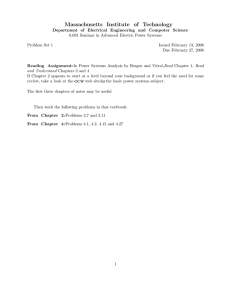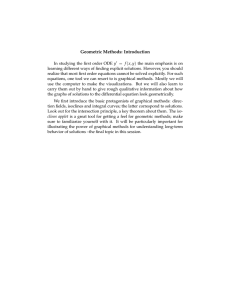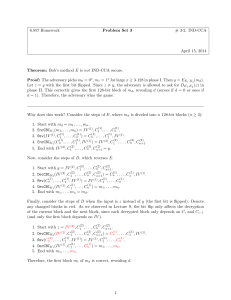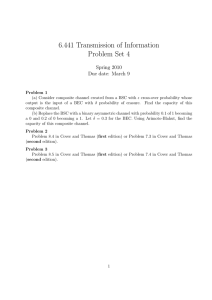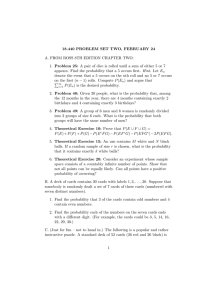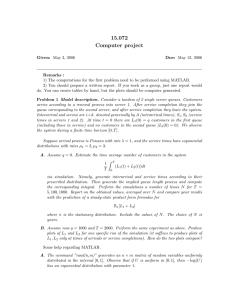Errata for the Fourth Printing Nancy Lynch
advertisement
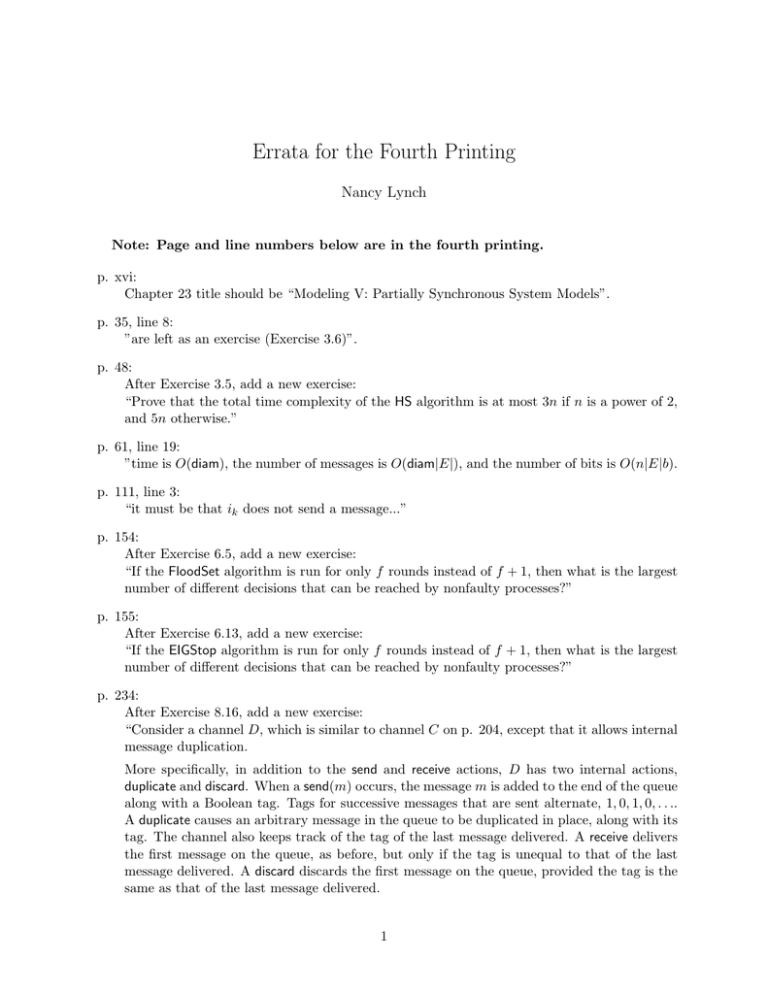
Errata for the Fourth Printing Nancy Lynch Note: Page and line numbers below are in the fourth printing. p. xvi: Chapter 23 title should be “Modeling V: Partially Synchronous System Models”. p. 35, line 8: ”are left as an exercise (Exercise 3.6)”. p. 48: After Exercise 3.5, add a new exercise: “Prove that the total time complexity of the HS algorithm is at most 3n if n is a power of 2, and 5n otherwise.” p. 61, line 19: ”time is O(diam), the number of messages is O(diam|E|), and the number of bits is O(n|E|b). p. 111, line 3: “it must be that ik does not send a message...” p. 154: After Exercise 6.5, add a new exercise: “If the FloodSet algorithm is run for only f rounds instead of f + 1, then what is the largest number of different decisions that can be reached by nonfaulty processes?” p. 155: After Exercise 6.13, add a new exercise: “If the EIGStop algorithm is run for only f rounds instead of f + 1, then what is the largest number of different decisions that can be reached by nonfaulty processes?” p. 234: After Exercise 8.16, add a new exercise: “Consider a channel D, which is similar to channel C on p. 204, except that it allows internal message duplication. More specifically, in addition to the send and receive actions, D has two internal actions, duplicate and discard. When a send(m) occurs, the message m is added to the end of the queue along with a Boolean tag. Tags for successive messages that are sent alternate, 1, 0, 1, 0, . . .. A duplicate causes an arbitrary message in the queue to be duplicated in place, along with its tag. The channel also keeps track of the tag of the last message delivered. A receive delivers the first message on the queue, as before, but only if the tag is unequal to that of the last message delivered. A discard discards the first message on the queue, provided the tag is the same as that of the last message delivered. 1 (a) Give formal code for automaton D, in the same style as the other code in this chapter. (b) Prove carefully that D implements C, in the sense of inclusion of sets of traces. Use a simulation relation.” p. 286: The precondition for set-flagi should use = instead of :=. p. 330: After Exercise 10.23, add a new exercise: : “Prove that the Bakery algorithm guarantees bounded bypass.” p. 425, line 6: “returned by the second of these two sets of reads (which...” p. 425, line 7: “by the first of the two sets of reads” What follows now is a collection of changes that would have to be made all together, for consistency. This change would simplify some arguments. The new observation is that we can omit Condition 1 in the statement of Lemma 16. It is implied by Condition 2, because β is a sequence. p. 434, line -1: Replace “four” by “three”. p. 435, line 1: Replace “four” by “three”. p. 435, Lemma 13.16: Remove the first condition and renumber the others. After the Lemma, remove the first sentence, explaining Condition 1, and renumber the men­ tions of Conditions 2, 3, and 4 in the rest of this paragraph as 1, 2, and 3. Modify the proof to begin with: “We begin by claiming that for any operation πinΠ, there are only finitely many operations φ such that φ < π. This is because, if there were infinitely many such operations φ, then by Condition 1, all of their invocation events would have to precede the response event of β. (The fact that β contains no incomplete operations implies that such a response event does in fact appear in β.) But β is a sequence, so no element can have infinitely many predecessors, a contradiction. Now we describe how to insert a serialization ....” p. 435, line -6: Instead of “Condition 1 implies”, say “The claim at the beginning of this proof implies”. p. 436, line 13: Condition 1 p. 436, line 18: Condition 2 2 p. 436, line 19: Condition 3 p. 439, line 14: Replace “four” with “three”. p. 439: Remove the entire proof numbered 1, which spans from line 16 to line -7 on the page. Renum­ ber the remaining three parts as 1, 2 and 3 instead of 2, 3 and 4. p. 443, line -3: Replace “four” with “three”. p. 443, line -2 and -1: “Conditions 2 and 3 are immediate, so all we must show is Condition 1. For this, the following...” p. 444, line -15 and -14: Omit the tiny paragraph “Using Claims 13.24 and...an exercise” p. 453: Omit Exercise 13.27. p. 444, line 13: Replace “For Condition 2,” with “To show Condition 1,” p. 580, line 1: Replace “four” with “three”. This is the end of coordinated set of changes. p. 700, lines -1 and -2: Four instances of α should be α� . p. 731: After Exercise 22.13, add a new exercise: : “Prove that the Probe protocol is not message bounded. Do this by showing, for each k, how to produce a complete execution α that has no k-extensions.” p. 736, line -12: Replace “lower” with “lower(C)”. 3 MIT OpenCourseWare http://ocw.mit.edu 6.852J / 18.437J Distributed Algorithms Fall 2009 For information about citing these materials or our Terms of Use, visit: http://ocw.mit.edu/terms.
